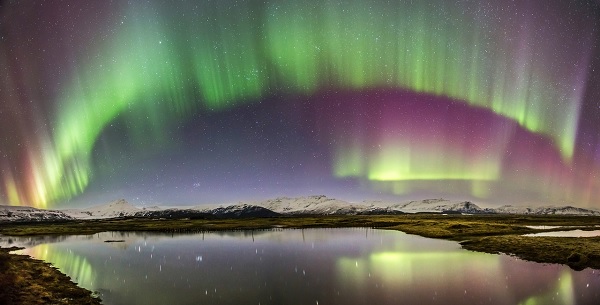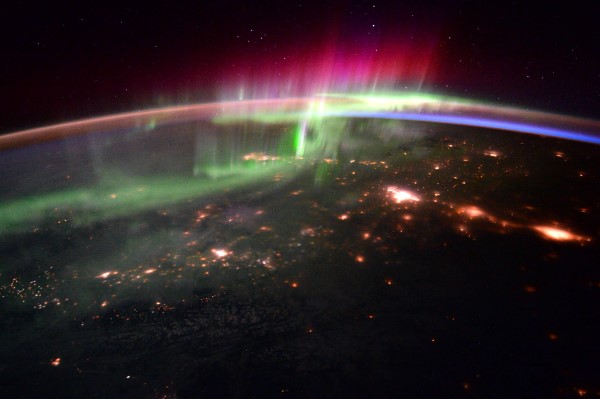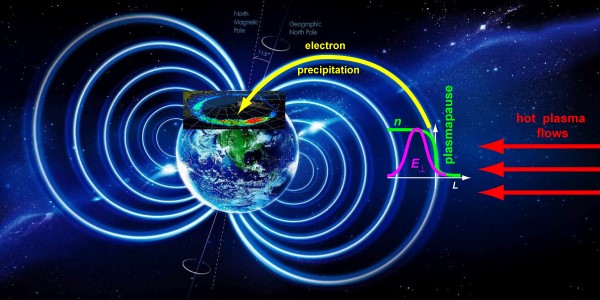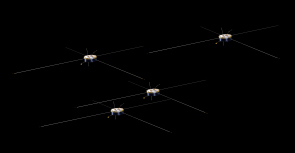Auroral substorms triggered by 'short circuiting' of plasma flows
31 July 2020
Auroras are a marvel to behold, but deciphering the complex interactions that take place to cause this display is challenging. New research using data from multiple spacecraft, including ESA's Cluster mission, has revealed the cause behind the sudden brightening of the auroral oval before it breaks up into a substorm. |
| Aurora over Icelandic lake. Credit: C. Gauna |
On Earth, auroras occur when the solar wind – a stream of charged particles continuously released by the Sun into interplanetary space – interacts with our planet's magnetic field to produce an array of colour in the polar night skies. High energy particles collide with gases in the atmosphere and raise the energy levels of atoms and particles there. As these decay back to normal energy levels, they emit colourful light that is visible as the aurora.
The solar wind is a plasma made of charged particles – negatively charged electrons and positively charged ions – embedded with a magnetic field. When the solar wind reaches Earth, it is met by the planet's magnetosphere, which is the protective magnetic field that envelops the planet and stretches out into space. The wind compresses the magnetosphere on the Earth's Sun-facing side and creates the magnetopause, causing most particles to flow around the planet and drag the magnetosphere out into a long tail on the night-side.
When the magnetic field from the solar wind interacts with the magnetosphere at the magnetopause, it is possible for some solar wind particles to enter the magnetosphere. The magnetic fields in the magnetotail become stretched and then 'pinch' together in a process known as magnetic reconnection. This releases energy and accelerates charged particles back towards Earth to create what scientists refer to as the auroral substorm.
Observing Earth from space, the aurora appears as an oval around the poles, which is visible to an observer on the ground as a quiescent glow. A substorm is the phenomenon by which the dormant aurora springs to life through sudden brightening and increased movement. Just before the oval breaks up into a substorm, an auroral streamer – a small arc – moves towards the equator and localised brightening occurs at the inner edge of the oval.
 |
| Aurora over northern Canada, seen from the International Space Station. Credit: ESA/NASA |
In a recent study published in JGR Space Physics, Evgeny Mishin from the US Air Force Research Laboratory in Albuquerque, New Mexico, and Anatoly Streltsov from Embry-Riddle Aeronautical University in Daytona Beach, Florida, investigated the reason as to why this brightening only occurs in a particular area – a mystery that has been puzzling scientists since the 1960s.
The auroral streamer that signals the arrival of the substorm is actually the ionospheric signature of the plasma flow that has been flung towards Earth following magnetic reconnection in the magnetotail. The scientists wondered how the plasma flow could supposedly inject energetic electrons into such a large area of the plasma sheet – the central region of the magnetotail where the plasma is denser – yet the enhanced precipitation of electrons that causes the brightening only occurred in a narrow region.
They decided to test a theory according to which the high energy electrons, called 'hot' electrons, are blocked when they reach the plasmapause – the outer boundary of the plasmasphere which sits within the magnetosphere – while the hot ions continue into the sub-auroral zone, an area of lower latitude than the auroral zone. Previous laboratory experiments by other researchers have helped to form this theory by showing how plasma flows can penetrate magnetic barriers.
"When the flow penetrates into the plasmasphere, where the plasma is dense, the background electrons neutralize, or short circuit, the polarization electric fields inside the flow," explained Mishin.
"As a result, the hot electrons stop but hot ions penetrate further Earthward, creating an enhanced electric field in the sub-auroral zone. This process works as a power plant at the plasmapause converting the kinetic energy of incoming plasma flows into the electromagnetic energy."
 |
| Auroral substorms triggered by 'short circuiting' of plasma flows. Credit: E.Mishin and A. Streltsov / Holzworth and Meng, NSSDC, NASA |
The hot plasma flow causes what is known as a sub-auroral ion drift (SAID), which is a narrow westward-moving plasma stream driven by the strongly enhanced and localised electric fields. The hot ions that penetrated the plasmasphere and created the electric field associated with the SAID are, eventually, stopped by this field.
Mishin and Streltsov found that, when the electrons come to a halt during the short circuiting process, they pile up and this creates turbulence in a narrow region at the boundary of the plasmasphere. They call this region the turbulent plasmasphere boundary layer (TPBL). Low frequency plasma waves in the TPBL interact with energetic electrons in the plasma sheet, and it is this wave-particle interaction that causes the enhanced electron precipitation to brighten a small region of the auroral oval.
To test this theory, the scientists combined data from multiple spacecraft to get as many views of several auroral events as possible. They used measurements from ESA's four Cluster spacecraft – which celebrate 20 years since their two launches in July and August 2000 – along with the US Air Force's Defense Meteorological Satellite Program (DMSP) and NASA's five THEMIS satellites and two Van Allen Probes, spanning over two decades of observations in Earth's magnetic environment.
The satellite measurements were used to identify the sudden brightening of the oval at the onset of a substorm, and to find corresponding enhanced low-frequency plasma waves in the TPBL, and enhanced electron flux caused by the pile up of electrons.
 |
| Artist's impression of the Cluster spacecraft. Credit: ESA/ATG medialab |
The sudden brightening of the auroral oval has been a longstanding problem in understanding the phenomenon of auroras that has typically been tackled used magnetohydrodynamic (MHD) theory. The new work has now shed light on a key aspect of auroral substorms.
"Our approach is a step beyond MHD," explained Mishin. "We use a novel concept developed to understand numerous laboratory experiments investigating the penetration of plasma jets through magnetic barriers. We expanded on this concept to include the short-circuiting process and plasma turbulence effects."
However, solving the mysteries of auroras is an ongoing effort, and there is still a lot to learn.
"We believe that one of the challenging problems of the auroral geophysics is the effect of the ionospheric feedback on the dynamics and various forms of auroras and, possibly, on the breakup of auroral substorms," adds Streltsov.
Besides the many scientific conundrums they pose, auroras keep fascinating people around the world with their lighting shows, providing an unforgettable experience to anybody who had the chance to see the polar lights in person.
"Explaining how the aurora works is a fascinating endeavour," said Philippe Escoubet, the Project Scientist for the Cluster mission at ESA. "Over the years, Cluster has enabled a leap forward in the field of auroral plasma physics thanks to the first multi-point measurements over this region, and also via collaborative work with other missions. This new result is yet another step in the right direction, making sense of our planet's magnetic environment."
"We are looking forward to a new mission called SMILE, currently being prepared by ESA in collaboration with the Chinese Academy of Sciences," concludes Escoubet. "SMILE will study the auroras in detail by making global imaging for more than 40 hours continuously, four times the longest previous measurements."
Notes for editors
"Prebreakup Arc Intensification due to Short Circuiting of Mesoscale Plasma Flows Over the Plasmapause" by E. Mishin & A. Streltsov (2020) is published in the Journal of Geophysical Research: Space Physics.
The Cluster Science Archive can be found at the following link: https://csa.esac.esa.int
For further information, please contact:
Evgeny Mishin
Space Vehicles Directorate
Air Force Research Laboratory
Kirtland AFB, Albuquerque, NM, USA
Email: evgeny.mishin![]() us.af.mil
us.af.mil
Anatoly Streltsov
Embry-Riddle Aeronautical University
Daytona Beach, FL, USA
Email: streltsa![]() erau.edu
erau.edu
Philippe Escoubet
Cluster Project Scientist
European Space Agency
Email: Philippe.Escoubet![]() esa.int
esa.int


